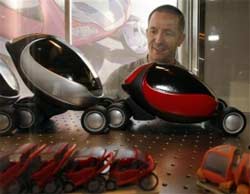Scientists, engineers, and architects at the Massachusetts Institute of Technology (Cambridge) are working on the "City Car," a rechargeable, two-passenger vehicle that promotes socially responsible transportation in heavily populated and pollution congested urban centers.
The golf cart-sized City Car would contain computers that locate a parking spot, lithium-ion batteries that automatically recharge themselves, a mechanism that would collapse itself in half so it could be stored with other such City Cars, much like how shopping carts are stacked in grocery stores and supermarkets.
The designers imagine it will park in a space about one-eighth the size of an average car. Plus, the 1,000-to-1,200-pound City Car is totally pollution free in operation, helping to clear the skies over major cities, hopefully, all over the world.
The lightweight electric vehicle could be inexpensively mass-produced, rented by commuters using a shared business model (that is already working successfully for bicycles and motorbikes in certain cities).
People in the city could get off the subway or bus and select a City Car from the front of the stack. Many different central areas around the city—next to bus stops, subway exits, train stations, etc.—would have assess spots for City Cars.
A person wanting to use a City Car would just insert their credit or debit card, take the first City Car that is available, and drive off to their destination, which would be near to another group of stacked City Cars.
The City Car is a project by MIT’s Media Lab and Smart Cities Group, specifically headed by William J. Mitchell and worked on by students with various degrees in aeronautics, visual arts, mechanical engineering, industrial designers, and architectureA full-sized model has yet to be built, but a small prototype version has been constructed. The City Car is centered around its wheels, which are called 'Wheel Robots' by the Media Lab team. They allow the vehicle to spin 360 degrees for ease of motion and parking.
In fact, Ryan Chin, who is the project coordinator for the Smart Cities, Media Lab project, says, “For starters, there is no engine, at least in the traditional sense. The power comes from devices called Wheel Robots, which are self-contained, digitally controlled robotic wheels, complete with their own suspension and very simple connections to the car body.”

